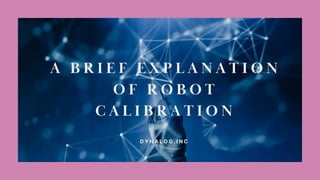Robot Calibration in Brief | Dynalog,Inc
•
0 likes•18 views
To comprehend robot calibration, view this presentation. For additional information, go to the official website of Dynalog, Inc.
Report
Share
Report
Share
Download to read offline

Recommended
More Related Content
Similar to Robot Calibration in Brief | Dynalog,Inc
Similar to Robot Calibration in Brief | Dynalog,Inc (20)
MGC_DVCon_13_Easy_Steps_Towards_Virtual_Prototyping_Using_the_SystemVerilog_D...

MGC_DVCon_13_Easy_Steps_Towards_Virtual_Prototyping_Using_the_SystemVerilog_D...
Recent progress on programming methods for industrial robots

Recent progress on programming methods for industrial robots
An Integrated Prototyping Environment For Programmable Automation

An Integrated Prototyping Environment For Programmable Automation
Design and Implementation of an Unmanned Ground -ICAM_2014_Paper_submission

Design and Implementation of an Unmanned Ground -ICAM_2014_Paper_submission
Welcome to International Journal of Engineering Research and Development (IJERD)

Welcome to International Journal of Engineering Research and Development (IJERD)
Recently uploaded
Differences between analog and digital communicationanalog-vs-digital-communication (concept of analog and digital).pptx

analog-vs-digital-communication (concept of analog and digital).pptxKarpagam Institute of Teechnology
Recently uploaded (20)
Seizure stage detection of epileptic seizure using convolutional neural networks

Seizure stage detection of epileptic seizure using convolutional neural networks
Maximizing Incident Investigation Efficacy in Oil & Gas: Techniques and Tools

Maximizing Incident Investigation Efficacy in Oil & Gas: Techniques and Tools
History of Indian Railways - the story of Growth & Modernization

History of Indian Railways - the story of Growth & Modernization
analog-vs-digital-communication (concept of analog and digital).pptx

analog-vs-digital-communication (concept of analog and digital).pptx
Seismic Hazard Assessment Software in Python by Prof. Dr. Costas Sachpazis

Seismic Hazard Assessment Software in Python by Prof. Dr. Costas Sachpazis
UNIT-2 image enhancement.pdf Image Processing Unit 2 AKTU

UNIT-2 image enhancement.pdf Image Processing Unit 2 AKTU
8th International Conference on Soft Computing, Mathematics and Control (SMC ...

8th International Conference on Soft Computing, Mathematics and Control (SMC ...
Involute of a circle,Square, pentagon,HexagonInvolute_Engineering Drawing.pdf

Involute of a circle,Square, pentagon,HexagonInvolute_Engineering Drawing.pdf
Software Engineering Practical File Front Pages.pdf

Software Engineering Practical File Front Pages.pdf
Developing a smart system for infant incubators using the internet of things ...

Developing a smart system for infant incubators using the internet of things ...
Robot Calibration in Brief | Dynalog,Inc
- 1. A B R I E F E X P L A N A T I O N O F R O B O T C A L I B R A T I O N D Y N A L O G , I N C
- 2. Robots have historically been taught manually, i.e. using the robot’s ‘teach pendant’ to manually drive the robot’s TCP to the desired point along the part to be operated on, while visually verifying – as much as feasible – the achieved accuracy. This is obviously a time-consuming process, to be painstakingly repeated for each (relevant) point along the robot’s path in space; furthermore, this process clearly doesn’t provide a high level of positional accuracy.
- 3. Robot Simulation software, commercialized nowadays by various companies, offers the ability to model an entire robot-cell on computer prior to dealing with it on the actual plant floor: a desired robot model is chosen, the end-effector and the fixture can be modeled, the part can be imported from some other CAD software – all that allowing the final robot program (with all required speeds and including any other desired commands) to be entirely created upfront through Simulation. The created robot program is – theoretically – ready to be executed on the actual robot: this process is referred to as Off-Line Programming (OLP). More specifically, ‘Downloading’ is the process of transferring robot programs created through Simulation software in a ‘nominal’ environment, to the ‘actual’ robot-cell on the plant floor;
- 4. In reality, the differences between the ‘nominal’ world in Simulation and the ‘actual’ environment on the plant floor prevent from directly executing on the robot controller a robot program created through Simulation: each robot unit is built with certain manufacturing tolerances; the end-effector and its TCP deviate from their design intent; the fixture holding the part is not located relative to the robot coordinate frame as desired; etc. As a result, the robot programs downloaded from Simulation will not follow the intended path on the plant floor. This doesn’t just affect the positioning of the robot’s TCP, but it can also cause collisions between the robot and other peripherals within the robot-cell.
- 5. A robot program generated through Off-Line Programming is accurate enough if the resulting positioning accuracy of the robot’s TCP is within the acceptable limits for the intended application. For example, Off-Line Programming resulting in good enough robot programs for a paint job might not be so for an engine component assembly application. To maximize the success of Off-Line Programming (minimum manual robot program touchup and collision avoidance), it is generally imperative to perform ‘Robot-Cell Calibration’, and to correct accordingly (i.e. ‘Filter’) the robot programs to be downloaded.
- 6. A robot is generally capable of repeating the same move towards a specific point in space, over and over, within a high level of tolerance (referred to as ‘unidirectional Repeatability’), generally well below 0.1mm. But this does not mean that that particular point in space is well known relative some global coordinate frame (such as the robot base frame): The level of ‘Absolute Accuracy’ achieved by an ‘off-the-shelf’ industrial robot is generally in the several millimeters and more. This is generally due to manufacturing tolerances for every robot unit, incorrect joint zero-mastering, mechanical flexibility, gear backlash, etc.
- 7. THANK YOU
